

2019 WINNER
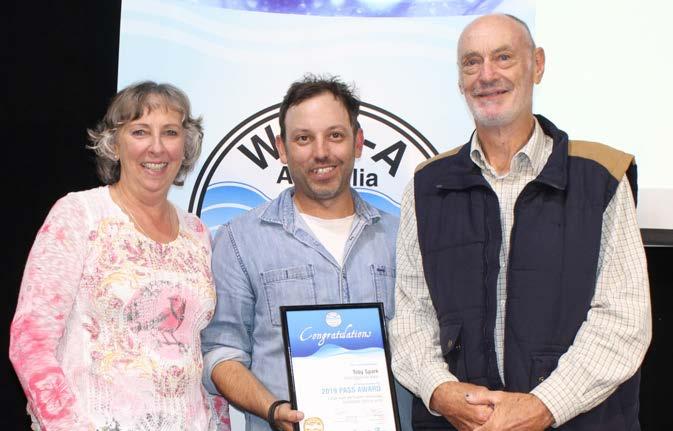
An award providing opportunity for water industry operational staff to share their in the field innovations & fixes to problems so that others in the water industry can benefit.

2019 PASS Award winner Toby Spark (C) from Gippsland Water with Jillian Busch (L) and Dave Barry (R) from Aqualift Project Delivery
2019 WINNER
Contents
Large Main Perforated Retractable
Disinfection Dosing Lance
Toby Spark
Gippsland Water
Saving our Wildlife
Shannon Thomas
Queensland Urban Utilities
Winneke Clarifier Launder cleaning by Trident ROV
John De Boer
Melbourne Water
Ballina WWTP Chemical Cleaning
Cost
Josh Writer
Ballina Shire Council
Sodium Fluoride Saturator Rapid
Media Cleaning
Mark Walker
Gippsland Water
Trenchless Repair to Sewer Above
Adelaide – Melbourne Railway Tunnel
Steve Rokicinski
SA Water Corporation
Valve Clamp
Andrew Povey
Wannon Water
Critical Control Point Rapid Alarms
Check
Tony Anderson
Gippsland Water

Large Main Perforated Retractable Disinfection Dosing Lance
Toby Spark, Water Quality Technician, Gippsland Water
THE PROBLEM
Gippsland Water has a number of large treated water transfer mains (450 mm and above) that are Trim chlorine disinfection dosed (re-chlorinated) with sodium hypochlorite. An ongoing issue has been managing and controlling disinfection residuals (mixing and dosing loop times) because of the large water main flow variations on dual direction pipes. Poor disinfection dosing and mixing can result in disinfection residuals appearing to not be maintained at appropriate levels to manage microbial risk, and this can send unrepresentative samples back to the chlorine analyser. This is primarily due to the dosing lance configuration in the main (only dosing top of the main). An additional issue has been the maintenance of dosing lances and the ability to access/withdraw them safely from the pressurised main.
How did the problem impact you or your work situation?
Poor dosing and mixing led to variations with the disinfection residual monitoring results and caused critical control point (CCP) disinfection alarms requiring staff to respond and check and verify the dosing system and reticulation/storage residuals. It also caused issues with deep mains and feedback sample loops. Mixing downstream was verified manually for disinfection and was adequate.
How long had the problem been occurring?
The problem has occurred for years across the entire Gippsland Water region where large main Trim disinfection systems are in place and significant flow variations occur. This creates issues particularly during high and low flow periods where mixing issues occur within the sample feed/ loop space/distance.
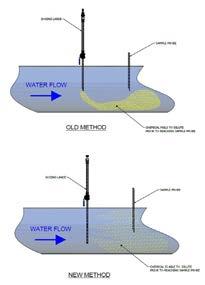
Graphic showing the old and new dosing methods.
THE SOLUTION

Mid stream dosing lance (traditional dosing) in the test rig.
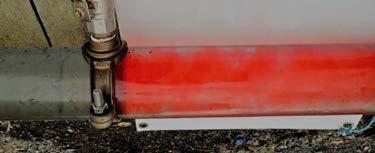
Full depth dosing lance (perforated lance) in the test rig.
I was frustrated with the time wasted from low chlorine alarms generated as a result of inadequate mixing. These alarms required a critical control point (CCP) alarm response to ensure public health was not compromised.
We (water quality team) tried to use process controls (loop times) to manage the monitoring to smooth the disinfection monitoring peaks and troughs in addition to trying various dosing lance configurations to ensure the best mixing outcome in the large mains.
We kept thinking we could do this better and smarter because the continual alarm generation was not truly representative of the water quality the customer may receive. Our aim is the continuity of supply of safe water to the customer. Investigation of options undertaken and consultation regarding perforated dosing lances across the diameter of the main to ensure homogenous mixing.
Who helped work on the solution?
Gippsland Water’s Water Quality team collaborated to take into account all issues across the region for a single solution option. Research was undertaken on-line and we identified a gap in the Australian water sector. We consulted engineers regarding dosing lances and designs to withstand flow forces and lance whip. The solution was developed, trialled and commissioned by the water quality team.
Describe the solution.
The sample dosing lance is a generic design that can be matched to the specific main size to ensure adequate volume of hypochlorite is delivered and mixing occurs across the entire diameter of the pipe, not just at the injection point and then relying on mixing in the pipe.
Thorough mixing occurs in a shorter space, so that when the sample is taken it is representative of the water in the pipe. This allows shorter loop times with homogenous samples fed into the analyser allowing to respond to the real alarms when they occur.
The solution is manufactured from readily available materials already in use in disinfection systems and comply with drinking water material requirements. As a result, maintenance and replacement costs are minimal. Importantly, the dosing lance can be constructed by technicians and is not a proprietary product keeping cost down. We have engaged contractors to manufacture the dosing lances. The solution is safer when working on the dosing lance as the perforated dosing lance with sleeve can be safely closed and removed or withdrawn without the operator getting saturated with water under mains pressure, or from residual chemicals in the lance.
How has it helped you at work?
The solution has seen many benefits including the following:
• Reduced travel time and non-productive work time associated with driving to sites to attend false high and low chlorine CCP alarms.
• Improved safety by being able to shut and withdraw or remove a dosing lance and prevent pressure spray from the main and/or hypochlorite (no more getting wet).
• Reduce the need for expensive capital investment such as static mixers and associated contractor costs to install and the ongoing maintenance and repair costs. We can use existing pits where dosing lances are already installed.
• A more stable residual in the set point range has ensured re-chlorination and contact times to maintain microbiological control as water enters the clear water storages.
• Improved Residual Trim dosing control in the reticulation systems ensures disinfection residuals are maintained in treated water storages.
• Improved water quality disinfection control during low flows in large mains frees up the water quality technician to concentrate on sampling, customer issues or compliant response, system mapping and assessments, as well as maintaining remote disinfection site operation. This means less time pressures to juggle competing priorities.
• Less customer complaints associated with flushing to maintain disinfections residuals (simulate high flows for improved disinfection dosing and control). Less overdose and underdose as the process control chased a set point.
• Less system shock can occur when a hydrant is opened up inadvertently creating water quality issues.
Suggest improvements, if time or financial limitations were not a factor.
The solution will be improved by modifying the safety wire for lance removal so we do not have to physically disconnect the dosing pipework to remove.
While we are still implementing and optimising, we expect to identify more improvements as we progress with installations.
Any other comments you would like to make?
This system makes the water quality technician’s life much easier and enables more time to be spent on system performance optimisation and drinking water supply operational activities such as basin or storage inspections and tank cleaning. The system is saving technician time from false critical control point disinfection alarms which when occurring during the night have business impacts such as overtime, fatigue management and 10 hour breaks. Imagine what it could do across a whole region in terms of efficiency savings and reducing risks to safe drinking water. Each lance costs approximately $500 to manufacture and has been designed to install into existing dosing tapping points.
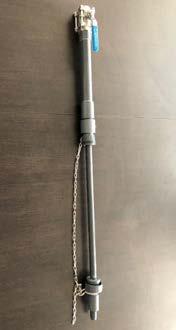
dosing lance extended.
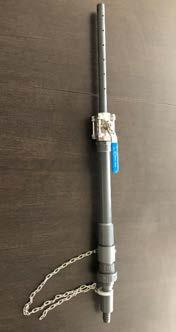
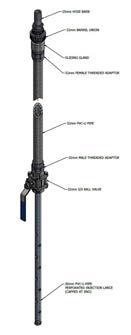
Saving our Wildlife
Shannon Thomas, Assistant Sewerage Treatment Plant Operator
Queensland Urban Utilities
THE PROBLEM
At the Beaudesert STP we were facing issues with our final effluent results. There were a few incidences where we had breached our licence due to having Coliforms in the effluent.
How did the problem impact you or your work situation?
Our work load increased significantly due to the constant monitoring of our CCT tanks along with the continuous cleaning of the tanks. As a huge animal lover, it infuriated me seeing the innocent ducking’s in the tanks.
How long had the problem been occurring?
The issue came about several times
THE SOLUTION
We rolled out a small investigation into why we were failing our release quality limits, we found that every time we failed there was decaying matter in the CCT tanks. We found that the main source of the issue was small animals (mainly duckling) falling into our humus tanks. We found ducks would fly into the humus tanks and the ducklings would follow, but once they would fly out the ducklings had no way of escaping.
Who helped work on the solution?
Both my managers Joseph McPhail and Mike Oakey played a huge part in the small project. Dave McConnell our site maintenance manager kindly did the installation.
Describe the solution.
I spoke to both of my managers about getting a barrier of some kind in place to prevent the ducking’s and other small animals falling into our tanks. They set aside a small budget to place a rubber footing at the bottom of the handrails around tanks to prevent any small animal being able to enter the tanks.
How has it helped you at work?
Since the installation our work load has dropped, and we have been able to successfully pass our licence and compliance limits. It has also been a massive weight off my shoulders knowing the native wild life is safe and free of harm.
Suggest improvements, if time or financial limitations were not a factor.
Although having such a small financial outlay, the project delivered a positive outcome and would be beneficial to any regional plant that is impacted by wildlife.

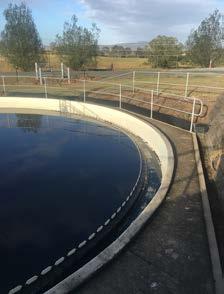
The rubber footings at the base of the handrails to stop animals getting in.
Shannon with one of the rescued ducklings.
Winneke Clarifier Launder
Cleaning by Trident ROV
John De Boer, Water Supply Operations Specialist, Melbourne Water Northern Operations
THE PROBLEM
Winneke Water Treatment Plant is designed to produce up to 560 ML/d. The treatment process includes Clarification, Filtration, Chlorination, Fluoridation and pH correction. The plant has 5 clarifiers that are 45 meters wide and a total of 16 sand filters. Each clarifier has 46 settled water launders that are over 12 meters long with no access platforms to allow maintenance cleaning of the launder.
For many years the Winneke clarifiers have experienced issues with large volumes of pinfloc building up on the surface of the settled water launders. This build up often reaches the point where the launder orifice becomes partially blocked. This can create significant process issues with high settled water turbidity’s being transferred to the filter beds, particularly during significant changes in plant flow rates.
Cleaning of the launders by traditional methods requires lowering of the clarifier water level. This can only be achieved via the desludge valve, resulting in the loss of the clarifier sludge blanket which can take several weeks of operation to re-establish. The clarifiers are only dewatered and cleaned every 5 years which far exceeds the time taken for the build-up of pinfloc to occur.
How did the problem impact you or your work situation?
Excessive build up on the launders increases the risk of turbidity carryover to the sand filters and blinding of the filter beds. This results in decreased plant throughput, excessive filter backwashing and potential HACCP events.
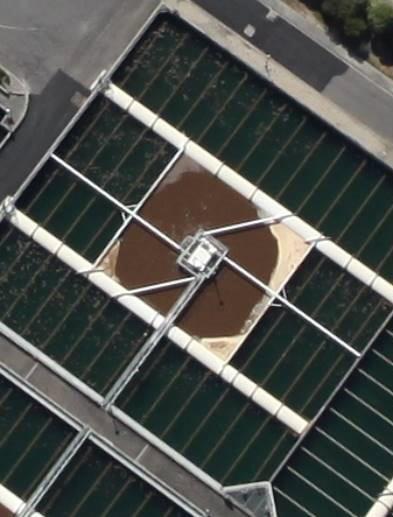
These elevated turbidity levels can also result in increased polymer dose rates which can also be detrimental to filter performance. This has the potential to significantly impact on Operations workload with events requiring manual extended backwashes to all 16 sand filters.
How long had the problem been occurring? This problem was inherent in the original plant design which has been in operation over 38 years. Early photos taken in the 1980’s show operators attempting to clean the launders with makeshift brushes and hose connections.
The Winneke WTP clarifiers.
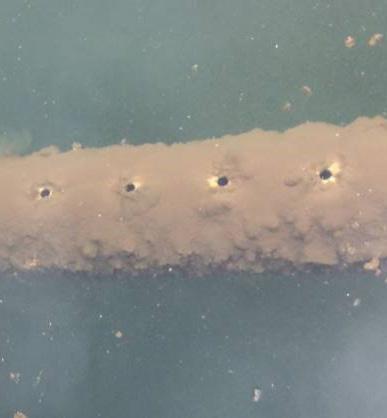

THE SOLUTION
Initially, we trialled the use of a curved brush and extendable pole but this only allowed us to clean the first 6 metres of the launder leaving the remaining 6 metres untouched.
Over the past 3 years, Melbourne water has introduced a number of submersible ROV’s into the Operations teams to facilitate underwater asset inspections.
It was decided to trial the use of our “Trident” ROV as a vehicle to drive a brush arrangement along the launder pipe to remove the built up solids.
Who helped work on the solution?
Winneke Operators, Will Kidd and Matt Slater assisted with the ROV operation during this trail with technical assistance provided by our in-house Water Quality technologist, Nigel Garson.
Describe the solution.
The “Trident” submersible ROV was retrofitted with a prototype curved brush and lowered onto each launder pipe. The Trident was then simply driven along the launder allowing the brush to clean the launder as it went. When full scale cleaning is undertaken, the plant will be taken offline allowing the disturbed sediment sufficient time to settle into the sludge blanket below without impacting on plant settled water turbidity.
How has it helped you at work?
Regular cleaning of the clarifier launders is an important part of our overall clarification management strategy. This trial demonstrated that we can now achieve this for most launders with minimal effort.
Pinfloc buildup on the launders.
Pinfloc released from the launders.
Suggest improvements, if time or financial limitations were not a factor.
With more time and additional finance, we could have a purpose built brush attachment designed and constructed to optimise the weight and buoyancy of the unit and improve its overall durability. We could also look at other remote options to clean the inside of the launder pipes and main collector manifolds, removing the requirement for confined space entry.
Installation of additional walkways would also allow access to some of the launders that are not easily accessible, even with the ROV.
Any other comments you would like to make?
This trial was a great opportunity to use technology to tackle an age old issue and have a bit of fun at the same time.
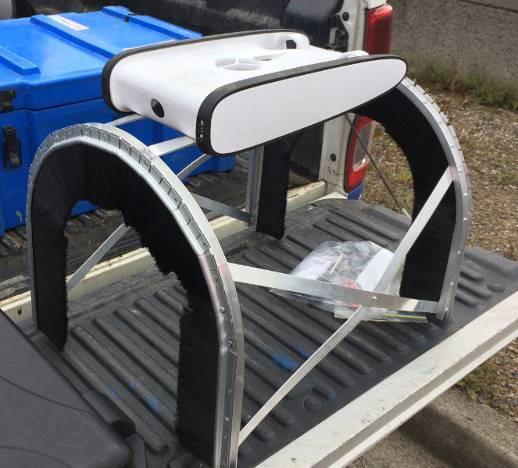
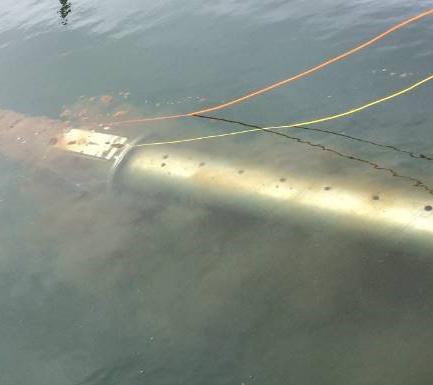
The brush arrangement powered by the ROV.
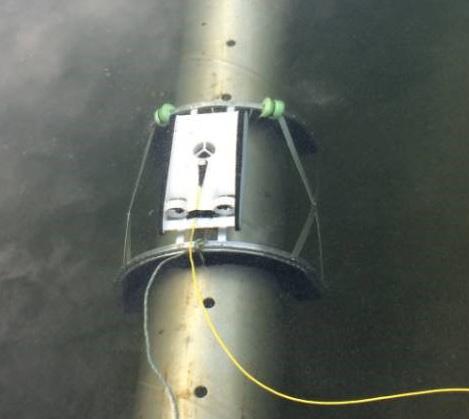
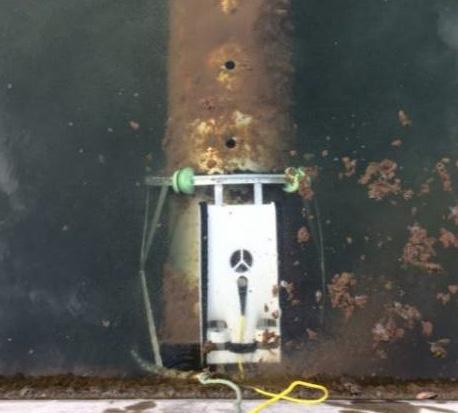
A partly cleaned launder.
A fully cleaned launder. The cleaning system in use.
Ballina WWTP Chemical Cleaning Cost
Josh Writer, Water and Wastewater Treatment Plant Operator, Ballina Shire Council
THE PROBLEM
Membrane fouling is an unavoidable obstacle that all membrane plants, especially Membrane Bioreactors, need to combat. In early 2014, Ballina WWTP experienced severe membrane fouling issues, both organic and inorganic in nature. This resulted in costly and labour intensive manual cleans. The issue has since been mitigated through the use of Oxalic acid as a clean in place (CIP) chemical and through abiding by a strict chemical cleaning regime based on the Transmembrane Pressures (TMP) of each membrane deck. In our MBR arrangement, Oxalic acid is used to inhibit inorganic fouling, predominantly caused by Aluminium Sulfate dosing used upstream for phosphorus removal. Though it has helped to prevent the need for manual cleaning, the use of Oxalic acid raised other concerns such as the high cost of the chemical and troubles associated with its storage. We have 14,400 flat sheet membranes in total, with each of the 8 decks requiring an Oxalic clean approximately twice a year. Previously the chemical was purchased as a solution in an IBC which cost $2,600 and would only be enough to clean one deck. The cost of these cleans were quickly adding up.
How did the problem impact you or your work situation?
• The use of this expensive chemical depleted the budget and prevented us from utilising the funds on capital works projects and asset replacement that were also required for our relatively small 5.43 ML/d plant.
• Storing multiple IBCs in onsite bunds took up valuable real estate.
• When the chemical was stored for long periods of time, we found that the active chemical was precipitating out of the solution (especially in the sun).
• The containers were difficult to move and until recently, we didn’t have a forklift requiring a contractor to be hired to move them into position.
How long had the problem been occurring?
Ballina WWTP was commissioned in early 2013. In 2014, we experienced extreme caking and fouling issues that resulted in two manual cleans that lasted 6 months. We combated this issue through the use Oxalic acid solution and in early 2018, we changed to Oxalic Acid Dihydrate as a more cost effective substitute.
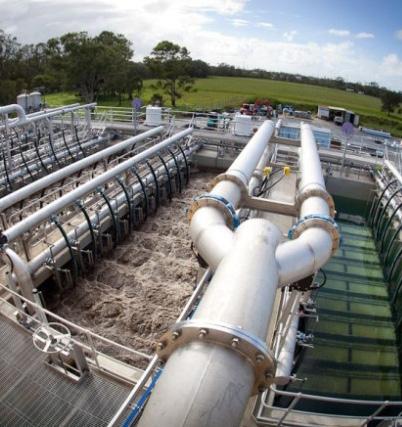
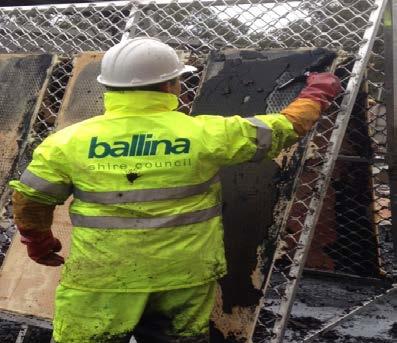
THE SOLUTION
I stumbled across the solution by chance when I was researching chemicals to use to clean my timber deck that was discoloured. One product I researched was Oxalic Acid Dihydrate, which is used in the boating industry as a bleaching and cleaning agent for the decks of ships. This got me thinking about batching our own Oxalic solution onsite.
Some research regarding safety of the product and a risk assessment was conducted. We found that the chemical was approved to be used on our Kubota flat sheet membranes. Our chemical supplier was able to supply us with 25 kg bags of a granulised Oxalic Acid Dihydrate, with an equivalent strength CIP having a cost of $235. After approaching the other operators and our engineer about the idea, we proceeded to purchase three bags of the powder to complete further testing.
After calculating the correct dose rates and strengths to suit our application and to meet manufacturers requirements, we conducted a small scale bench test in the lab by simulating a CIP on some old pieces of membrane. We compared the old product with the new chemical that we had batched up with water to get the correct concentration. After an hour of soaking time, the results were recorded and the pH of both solutions checked. The results looked identical. We proceeded to run a full scale trail and are yet to look back.
Who helped work on the solution?
The other operators at Ballina WWTP deserve a big thank you, namely Brendan Sanders who persisted with the idea from the beginning. Our process engineer assisted in purchasing and helped with the safety equipment that was needed. There is more work and some risk involved for us in having to batch up the solution, although we all agree that when done correctly, the cost savings are worth it.
Describe the solution.
We have created a rudimentary batching rig that includes an old IBC with a hatch we have cut out of the top. In collaboration with our engineer, we conducted a risk assessment regarding the safety requirements and the PPE that was needed to complete the job safely. We originally were mixing the powder with water using a drill and paint mixer. We eventually got the approval to purchase a tote mixer with a variable speed drive and also installed a timer that removes any risks of splashes and exposure to the acid.
It takes about 30 minutes of labour to batch the 1000 L of chemical required to complete our chemical cleans. The batching process is fairly basic and involves us getting kitted up in overalls, gloves, respirators and eye protection. As the product is granulised and damp in nature, we have found that dust isn’t an issue at all. We empty the required amount of bags into the IBC, top up the rest with water, and mix the solution until it has dissolved.
How has it helped you at work?
The major reason we implemented the change is the 90% cost saving that it provided which will amount to tens of thousands of dollars each year. As this product is supplied in 25 kg bags, it is easier and cheaper to transport and takes up less space onsite. We can store enough chemical on a bunded pallet for one year’s worth of chemical cleans.
It also removed the need for a forklift to complete the task, as we no longer need to relocate the IBCs. The previous product had a tendency to precipitate out of solution over time. The new Dihydrate product has a shelf life of 12 months and it can be freshly batched which has solved this issue.
The strength of the solution can be optimised by adding or removing extra bags, depending on the extent of the fouling, where we were limited in this capacity originally. We have found that four bags can drop the Transmembrane Pressures to a near new condition, while still meeting the manufacturer’s recommendations for maximum strength. The results from the chemical cleans that completed thus far show a similar if not better result from the batched Oxalic Dihydrate and the time between cleans may have also been extended.
Suggest improvements, if time or financial limitations were not a factor. It would be great to automate the process using something similar to a gravimetric dry feed fluoride system. One of our next possible modifications will be to add a hopper that can hold bulk chemical that will eliminate any possible manual handling and exposure issues.
Any other comments you would like to make?
This solution was designed to work for our Kubota RW400 Flat Sheet membranes in a Membrane Bioreactor configuration but I believe it could also be adapted to any plant that currently doses Citric or Oxalic acid as part of its CIP regime. It may also be applicable to other dry chemicals that need to be dosed as a solution. Alongside the above changes, we have optimised the chemical dosing processes onsite and carefully control our MLSS levels which would otherwise aggravate the fouling issues. We have also experimented with Citric acid as a cost effective alternative in our low pH cleans, although the TMP drop was usually less than half of the Oxalic acid cleans.
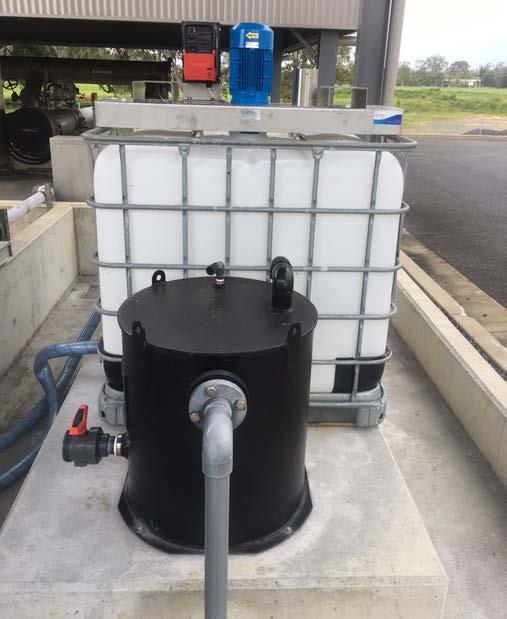
The new Dihydrate mixing system.
Sodium Fluoride Saturator Rapid Media Cleaning
Mark Walker, Water Treatment Technician, Gippsland Water
THE PROBLEM
Support media (19 (20kg) bags of 5mm sand) and filter media (13 (20kg) bags of 2mm sand) in the sodium fluoride saturator systems is purchased and “washed” when rebuild of the fluoride saturator occurs every 12-18 months.
While the media purchased is “washed” it still requires significant cleaning after being added to the fluoride saturator system, prior to return to service. This cleaning requires addition washing of the purchased media to remove fines and fine colloidal material prior to installation and use to avoid water quality issues. Previous attempts to rebuild saturator filters and wash the media in the fluoride saturator resulted in the media washing in the saturator taking 3-4 days by filling and draining (backwashing) after adding the support and filter media to the saturator.
How did the problem impact you or your work situation?
The time taken to physically wash the support and filter media resulted in significant Technician time being consumed (2 Technicians for multiple days) as part of the fill/empty cycling. This also resulted in the fluoride system being offline for >72 hours which resulted in notifications to the Department of Health and Human Services (DHHS) as required by the Fluoride Code of Practice.
How long had the problem been occurring?
Since the installation of the fluoridate system was reconfigured in approximately 2015 to require support and filter media.
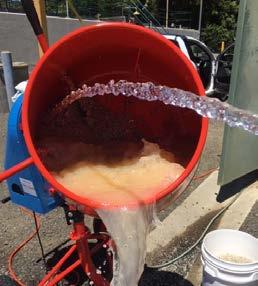
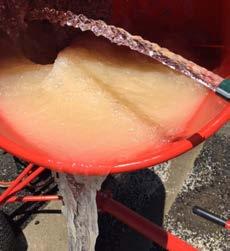
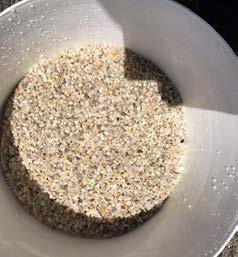
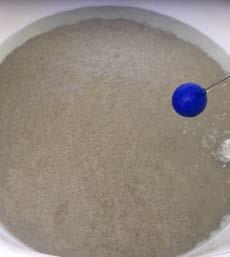
Pre-washed media being washed to clean.
Close up of the media with fines/ colloidal material still coming off through the washing process.
Bucket of washed media.
Final cleaned media added to the fluoride saturator ready for return to service.
THE SOLUTION
I was frustrated with the unproductive time required to wash the “washed” support and filter media to an acceptable quality and the time it took in the saturator.
I kept thinking that there had to be a better way to wash the media more efficiently and reduce the unproductive down time of filling and emptying the saturator when the support and filter media was added.
My thoughts were;
1. Wash the support and filter media external from the saturator in smaller batches. Only add it to the saturator when clean.
2. Washing could be undertaken independently of the fluoride system being offline, thereby not triggering the DHHS, 72 hour offline notification requirement
3. This would result in quicker washing of smaller batches, reduced time to clean and reduced unproductive time for our Technicians.
Who helped work on the solution?
Dion Bull (fellow Senior Water Treatment Technician) to sanity check my idea and identify any unintended issues I may have overlooked.
Describe the solution.
The solution involved instead of adding all the support and filter media into the saturator and fill and drain (backwash type method) which is labour and time intensive to clean, we used a cement mixer to wash the media in smaller batches with continuous running water. The media support and filter was cleaned in 20 kg batches and each batch transferred from the cement mixer to a bucket. When all the support and filter media was cleaned, the old media could be removed and the new media added to the saturator and levelled out. The fluoride system was only offline for a period of 6-8 hours. The saturator could then have the sodium fluoride powder added and turned on (returned to operation) immediately.
How has it helped you at work?
This has helped by decreasing the labour requirement to a single person from 3-4 days to 1 day (reduction by 1 person), using a cement mixer to clean the media, and returning to service and meeting our DHHS requirements of not having the fluoride system off line for greater than 72 hours.
We can pre prepare the media so that the only downtime (system off line) is when we remove the old media (vacuum truck) and reinstall the pre cleaned media in the buckets. By cleaning the media over time, the fluoride system stays operational until the last minute when the media removal and addition is required. It also provides flexibility with plant operations as Technicians are not time pressed to complete the rebuild and comply with the Code of Practice, 72 hour notification limit of the system being offline.
Suggest improvements, if time or financial limitations were not a factor. Not at this stage, however future media changes will identify additional efficiency and optimisations.
Any other comments you would like to make?
This process is quicker and improves system performance, time to return to service and enables you to take the time around existing operational activities to clean the media over days (in and around plant operations) for the one day of changeover required.
Trenchless Repair to Sewer Above Adelaide - Melbourne Railway Tunnel
Steve Rokicinski, Specialist Networks Operator, SA Water Corporation
THE PROBLEM
A sinkhole opened up on the corner of Bridge St and East Terrace in Murray Bridge, above the tunnel over the main Adelaide to Melbourne railway line. Along with the collapse of the road, kerbing and footpath, several underground assets were affected. These included a water main which subsequently had to be abandoned and back fed from another direction, a stormwater pipe that was completely destroyed, and a 225m sewer pipe that had been compromised.
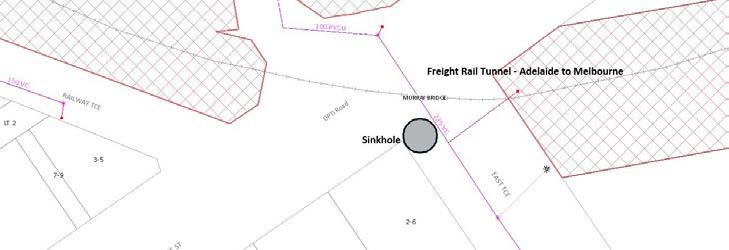
How did the problem impact you or your work situation?
I was asked to attend site and immediately assess the situation. In order to view the section of sewer with CCTV, I had to very carefully hydro-jet and vacuum out masses of gravel that had settled in the pipe. There was added pressure to do the job as this was a ‘no dig’ zone due to the railway tunnel beneath the site.
How long had the problem been occurring?
The problem was sudden but needed immediate attention in order to avert a potential disaster. It was unknown whether the sinkhole would open any further and completely collapse the sewer, compromise the railway line and other assets.
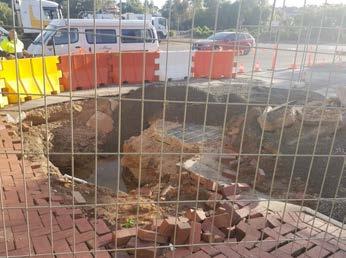
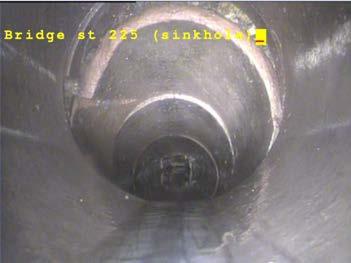
The sink hole at the surface.
The sink hole location above the railway tunnel.
CCTV showing extent of the hole.
THE SOLUTION
The impacted part of the sewer was in the ‘no dig’ zone. We had recently purchased a trenchless pipe repair system (Pipe Doctor). It appeared to be the most practical, safe and cost effective solution for the task at hand.
Who helped work on the solution?
My co-worker Dylan McKenzie and I planned what would be required for the job and how to execute a successful repair.
Describe the solution.
Pipe Doctor is a two-part silicate resin that is impregnated into a fibreglass patch. The patch is wrapped around an inflatable packer and pushed down the sewer pipe with air rods to the compromised section. The packer is inflated to a certain pressure and the patch is allowed to cure in place. In this case, we performed Confined Space Entry through the upstream manhole with sewer pump station isolations. We pushed the packer down the pipe for 22 m to the break and allowed the patch to cure for 100 minutes. The packer was then deflated, leaving behind a successful structural repair.
How has it helped you at work?
This repair has given me the confidence to tackle other, more difficult, situations. The introduction of trenchless repair has alleviated the need for digging, in many situations saving thousands of dollars, minimising safety risks and reducing the environmental impact and disruption to customers.
Suggest improvements, if time or financial limitations were not a factor. Further expansion of trenchless technology techniques in the organisation to cover a wider range of problems. To make more people aware and capable of undertaking trenchless repairs in the organisation reducing the risks associated with excavations and reducing the impact on customers.
Any other comments you would like to make?
This method of repair made, what seemed like a nearly impossible job, a successful outcome for all involved. It has also allowed me to continue to expand our capabilities in the trenchless repair area and we have now successfully completed over 50 jobs.
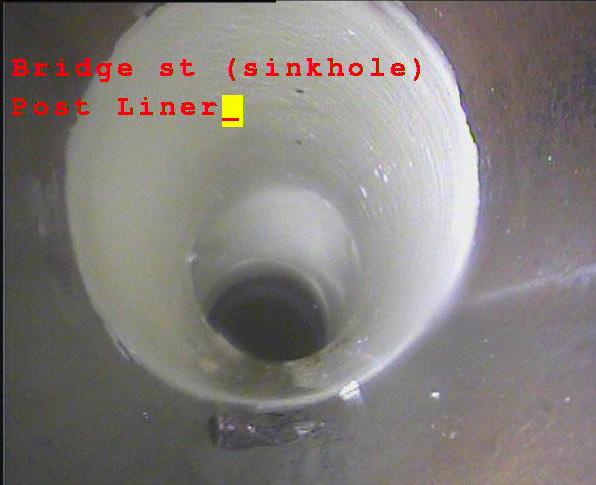
CCTV shot of the repaired sewer.
Valve Clamp
Andrew Povey, Team Leader Civil Maintenance, Wannon
Water
THE PROBLEM
Over recent years Wannon Water has had trouble with contractors turning on new water mains without consent and before they have been flushed and tested to ensure compliance with Australian Drinking Water Quality Guidelines.
Water theft was also an issue, as well as the inability to tag out or lock out a water main to prevent it being turned on while works are in process.
How did the problem impact you or your work situation?
Although no reported cases of Illness have been recorded, locking the valves removes the possibility of it ever happening in the future.
Recently the Valve Clamp also helped to enable locking out of a main that was directly feeding from a reservoir tower while divers where working on submerged valves. It removed any safety issues by removing the possibility of the divers being sucked into or onto the live tower outlets.
How long had the problem been occurring?
The problem of unsafe drinking water is always present when anyone has the ability to turn on valves prior to commissioning of a main.
The risk of valves being turned on when works are in progress, as well as water theft have been present for a long time.
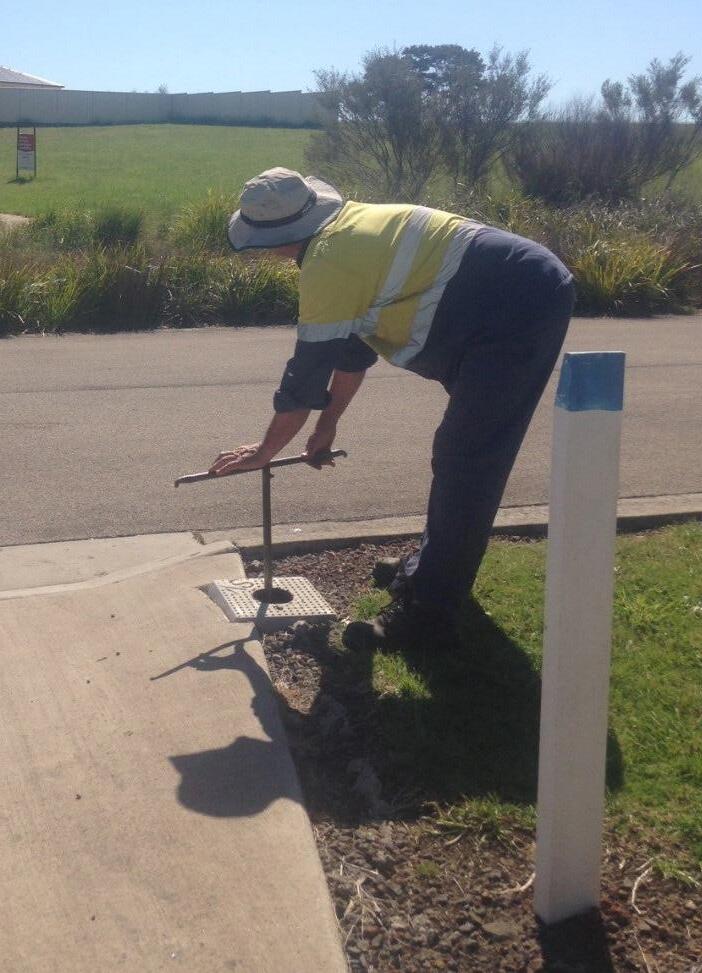
THE SOLUTION
After a request from my manager to design a clamp, I looked at what could be done to have a clamp that would be very hard to be tampered with.
The clamp had to fit over the valve head so that it could not be operated simply by turning the valve clamp. It also had to clamp to the valve and not just the valve cover as it could easily be removed.
Who helped work on the solution?
I had plenty of advice by my team members as they pass me in the work shop and asked what are you making. Some advice was useful and some thoughtful.
Describe the solution.
The solution was to design a valve clamp that could be locked and not be easy to remove. It needed to be transportable and user friendly to ensure it is used when required.
How has it helped you at work?
It was used recently to lock out a feeder main from a reservoir water tower that divers were working on. It created a safety barrier that prevented the main being turned on while the divers where working around the tower outlets.
Suggest improvements, if time or financial limitations were not a factor.
The Valve clamp could be made out of lighter material making it a little bit more user friendly. Also, if it was made in various lengths it would cater for very deep valves. The current design only suits mains that are between 500mm and 1200mm in depth.
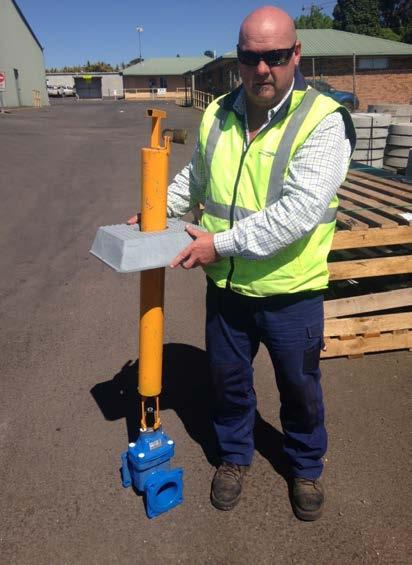
Any other comments you would like to make?
The Valve clamp has three main benefits
1: To ensure Safe drinking water.
2: Prevention of water theft.
3: Lockout/Tagout of mains.
The valve locking clamp.
Critical Control Point Rapid Alarms Check
Tony Anderson, Water Treatment Technician, Gippsland Water
THE PROBLEM
Gippsland Water has 16 water treatment plants that have various critical control point alarms (CCP) in place to manage plant processes and ultimately protect public health by supplying safe drinking water. Annually, the site operator challenge tests these alarms. The plant shutdown and escalation response protocols form part of the multi barrier approach to the protection of drinking water. The time taken to physically challenge test the alarms and complete the SMS responses/escalation protocols often affected plant production volumes and quality over the course of several days as the plant starts and stops.
How did the problem impact you or your work situation?
The time taken to physically challenge test all the alarms and SMS responses/escalation protocols often affected plant production and quality over the course of a few days. This resulted in a reluctance by technicians to commence the annual challenge testing.
How long had the problem been occurring?
The problem has been in existence for years across the entire Gippsland Water treatment plant workgroup comprising 16 water treatment plants. Our annual alarms verification challenge tests occur pre-summer, and the time taken to verify the entire alarm process, (alert alarm, critical alarm, SMS and escalation responses) can take several days for each plant when everything responds as expected. If an issue is identified that needs SCADA controls resolution, then re-testing and re-validation is required to prove that the problem has been rectified.
THE SOLUTION
I was frustrated with the time required to challenge test and validate the process CCP alarms across the WTP. This process took a long time to sequentially shut down the plant or process via each alarm to validate their effectiveness. The plant was then restarted for the next alarm to be checked.
I kept thinking that there had to be a better way to complete the process that was taking so many hours to complete (actual alarm time countdown). My thoughts were to change the response time form minutes to seconds for the challenge test. This would reduce overall time and allow validation of the alarm response quicker with virtually no risk to water quality safety.
Who helped work on the solution?
In addition to myself, Clinton Jolly from Gippsland Water’s SCADA team was instrumental in undertaking the programming required. This included documentation updates, programming validation and verification in line with Gippsland Water change management processes.
Describe the solution.
When in the “alarm test” mode, Clinton manipulated the code to count down in seconds, rather than the minutes under normal operation. This speeds up the whole verification process significantly. If you leave in test mode, the generated alarm is in seconds not minutes when a real event occurs. Just means a quicker response. Water quality CCP barriers compliance comply at all times, and alarms are live at all times.
How has it helped you at work?
Having the timers count down in seconds rather than minutes when in test mode has compressed the annual testing program down to hours per plant, rather than days. This is a significant saving in time and minimises process interruptions. As it is so easy now to test the alarm, challenge testing can be done far more frequently than annually if required. This is particularly helpful when any unrelated changes to the PLC or hardware have been made. You can immediately check whether the triggering of an alarm initiates the escalation processes that are expected to occur.
Suggest improvements, if time or financial limitations were not a factor. None at this stage as only year one but no doubt we will identify improvements as other technicians use the system across plants.
Any other comments you would like to make?
Absolute time saver and manages risk and public health so much better.
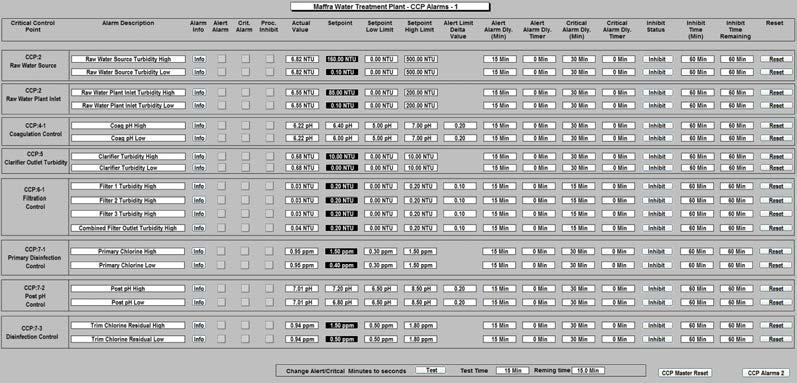
This is an IT solution to a practical treatment problem. The only thing to show is a button on the bottom of the CITECT control screen that the operator selects in order to test each alarm.

Award Objectives
• To create an opportunity which encourages water industry operational staff to share their in-the-field innovations and/or fixes to problems so that others in the water industry can benefit.
• To provide an application process which is easy to complete and utilises a standard template. This will give all water industry operational staff the same opportunity for presenting their innovation.
• To provide the opportunity for operational staff to receive recognition for their innovation and efforts.
• To encourage operational staff to become aware of and involved with the Water Industry Operators Association of Australia (WIOA).
To allow WIOA to share the good ideas and innovations with other members through the Operator magazine and/or other publications.
The Process
The PASS application template and more details on the Award can be found on the WIOA web site or from the WIOA office.
Judging
All PASS applications received in the 12 month period ending 1st March annually, will be assessed by an independent panel on a number of criteria, including:
• Commonality of the problem
• Benefit to OH&S, water quality, and/or the environment
• Financial and sustainability benefits
• Application to other industries
• Uniqueness, adaptability and simplicity
Reward
The person who submits the PASS application deemed best in that particular year will be announced the winner of the PASS Award at the annual WIOA NSW Conference. Aqualift Project Delivery Pty Ltd, as the PASS Award sponsor, will provide sponsorship of $2,500 for the winner to join the WIOA team on their annual operational tour of New Zealand including attendance at the New Zealand WIOG operations conference.
Previous Winners
2019 Toby Spark - Gippsland Water
2018 Michael Car tmer, Quinton Caird, Martin Zardins, Stephen Casey & Michael Dixon - Power & Water
2017 Marcus Boyd - Toowoomba Regional Council
2016 Daren Lord - TasWater
2015 Frank Rinaldo - North East Water
2014 Lester Little - TasWater
2013 Terry Randall & Danny Roberts - Port Macquarie Hastings Council
2012 Mark Walker - Gippsland Water
2011 Wayne Shaw - Gippsland Water
